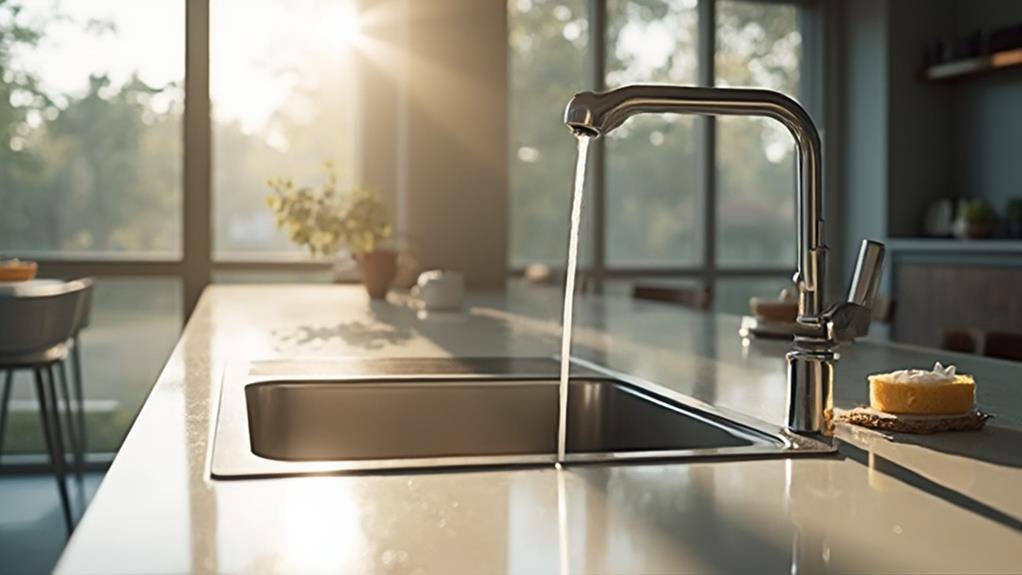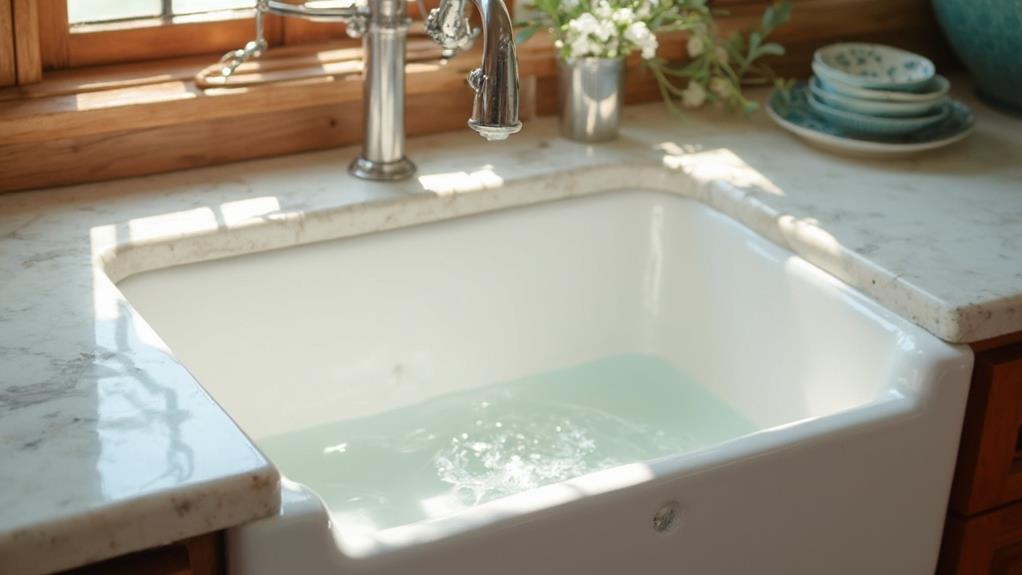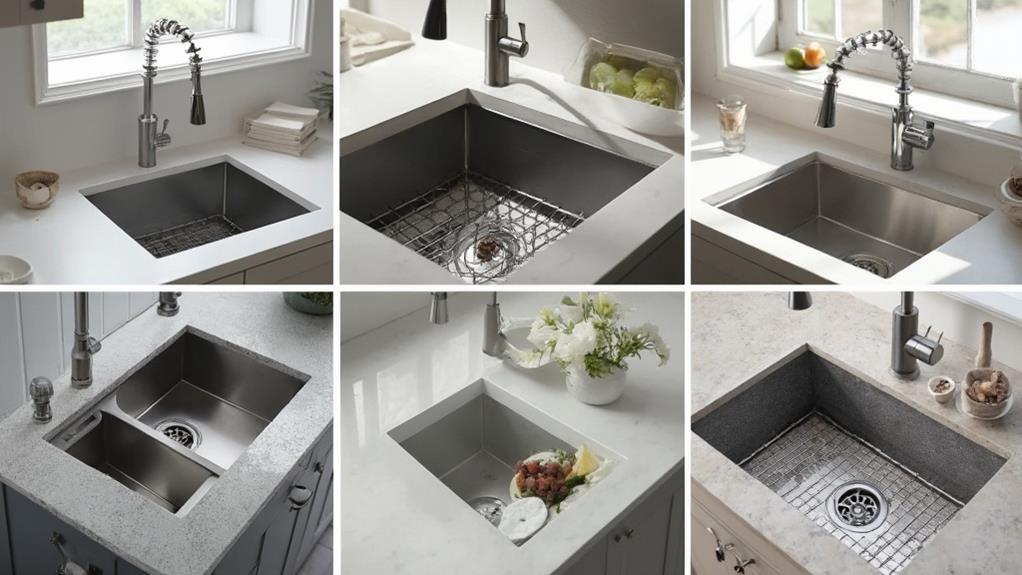When choosing a kitchen sink, you'll find various materials with unique pros and cons. Stainless steel is durable and affordable but can be noisy. Porcelain and ceramic offer elegance and easy maintenance but may chip. Composite granite resists scratches and heat but can be pricey. Copper sinks provide antimicrobial properties and a unique patina but require regular care. Fireclay boasts durability and style but is heavy and expensive. Cast iron sinks are sturdy and quiet but limited in color options and challenging to install. Each material has its strengths and weaknesses, so consider your priorities and budget before making a decision. Exploring further will help you find the perfect sink for your kitchen.
Stainless Steel Sinks

While many sink materials are available, stainless steel remains a popular choice for kitchens. It's durable, resistant to heat and stains, and relatively affordable. You'll find stainless steel sinks in various gauges, with lower numbers indicating thicker, more durable steel. They're available in different finishes, from mirror-like polished to brushed textures that hide water spots and scratches better.
One of the main advantages of stainless steel sinks is their versatility. They complement most kitchen styles and appliances seamlessly. They're also lightweight, making installation easier. However, they can be noisy when water or dishes hit the surface, though some models come with sound-dampening features.
Maintenance is straightforward; you can clean them with mild soap and water. But be aware that they can scratch if you're not careful. Hard water can leave spots, and acidic foods may cause discoloration if left too long.
When choosing a stainless steel sink, consider the depth and configuration. Deeper sinks offer more space for large pots but may require bending over more. Single, double, or triple bowl options are available to suit your needs and kitchen layout.
Porcelain and Ceramic Sinks
Many homeowners choose porcelain and ceramic sinks for their timeless elegance and durability. These sinks offer a classic look that complements various kitchen styles, from traditional to modern. You'll find them available in a wide range of colors and designs, allowing you to match your sink to your kitchen's aesthetic perfectly.
Porcelain and ceramic sinks are highly resistant to stains, scratches, and heat, making them ideal for busy kitchens. They're also easy to clean and maintain, often requiring just a quick wipe with a mild detergent. However, you should be cautious with heavy objects, as these sinks can chip or crack if something heavy is dropped on them.
One drawback is that porcelain and ceramic sinks tend to be more expensive than other options. They're also heavier, which might require additional support during installation. You'll need to use non-abrasive cleaners to avoid damaging the glossy finish. Despite these considerations, many homeowners find that the beauty and longevity of porcelain and ceramic sinks make them a worthwhile investment for their kitchens.
Composite Granite Sinks

Composite granite sinks have gained popularity in recent years due to their durability and aesthetic appeal. These sinks are made from a mixture of granite stone dust and acrylic resins, offering the look of natural stone with added benefits. They're highly resistant to scratches, chips, and stains, making them ideal for busy kitchens.
You'll find that composite granite sinks come in a variety of colors and finishes, allowing you to match your sink to your kitchen's decor. They're also heat-resistant, capable of withstanding temperatures up to 535°F without damage. This means you can safely place hot pots and pans directly in the sink without worry.
However, these sinks aren't without drawbacks. They're generally more expensive than stainless steel or porcelain options. Additionally, while they're durable, they can still be chipped or cracked if heavy objects are dropped on them. Some users report that these sinks can be prone to water spots and may require regular cleaning to maintain their appearance.
Despite these minor issues, many homeowners find that composite granite sinks offer an excellent balance of style, durability, and functionality, making them a worthy investment for their kitchen.
Copper Kitchen Sinks
With a warm, rustic charm, copper kitchen sinks have become increasingly popular among homeowners seeking a unique focal point for their kitchen. These sinks offer a distinctive aesthetic that evolves over time, developing a beautiful patina that adds character to your space.
Copper sinks are naturally antimicrobial, which helps keep your kitchen hygienic. They're also durable and resistant to rust and corrosion. You'll find that copper sinks are excellent at muffling noise, making them quieter than many other sink materials.
However, copper sinks require regular maintenance to preserve their appearance. You'll need to avoid harsh chemicals and abrasive cleaners, as they can damage the surface. Copper is also a softer metal, so it's more susceptible to scratches and dents.
Cost is another factor to consider, as copper sinks are typically more expensive than other options. They may also develop a greenish patina over time, which some homeowners find desirable while others prefer to prevent.
Despite these considerations, if you're looking for a statement piece that combines functionality with artisanal appeal, a copper sink might be the perfect choice for your kitchen.
Fireclay Sinks

Renowned for their durability and timeless elegance, fireclay sinks have become a popular choice for both traditional and modern kitchens. These sinks are crafted from a mixture of clay and glaze, fired at extremely high temperatures, resulting in a non-porous, chip-resistant surface. You'll appreciate their ability to withstand heavy use and resist stains, making them ideal for busy households.
One of the main advantages of fireclay sinks is their versatility in design. They come in various styles, from farmhouse to undermount, and can be customized with different colors and finishes to match your kitchen's aesthetic. However, you should be aware that fireclay sinks are heavier than most other options, which may require additional support during installation.
While fireclay sinks are generally low-maintenance, they can be prone to chipping if heavy objects are dropped on them. They're also more expensive than many other sink materials, which might be a consideration for budget-conscious homeowners. Despite these drawbacks, the longevity and classic appeal of fireclay sinks often make them a worthwhile investment for those seeking a durable and stylish kitchen centerpiece.
Cast Iron Kitchen Sinks
Cast iron kitchen sinks have been a staple in homes for generations, and for good reason. These durable sinks are made by pouring molten iron into molds and coating them with a thick layer of enamel. The result is a heavy-duty sink that's resistant to scratches, stains, and chips.
You'll find that cast iron sinks retain heat exceptionally well, keeping your dishwater warmer for longer. They're also incredibly quiet, reducing noise from running water or clanking dishes. The smooth enamel surface is easy to clean and maintain, often requiring just a simple wipe-down.
However, cast iron sinks aren't without drawbacks. They're extremely heavy, which can make installation challenging and may require additional support in your countertop. The enamel coating, while durable, can chip or crack if you drop heavy objects on it. Repairs can be costly and may not perfectly match the original finish.
Color options for cast iron sinks are typically limited compared to other materials. You'll also find that they're more expensive than many alternatives. But if you're looking for a classic, long-lasting sink that can withstand daily use, a cast iron option might be perfect for your kitchen.
Conclusion
You've now navigated the sea of sink options, each with its own unique traits. Whether you're drawn to the timeless appeal of stainless steel or the rustic charm of copper, remember that your choice will be the heart of your kitchen for years to come. Consider your lifestyle, budget, and aesthetic preferences when making your decision. With the right sink, you'll be washing away your worries and creating culinary masterpieces in no time.

